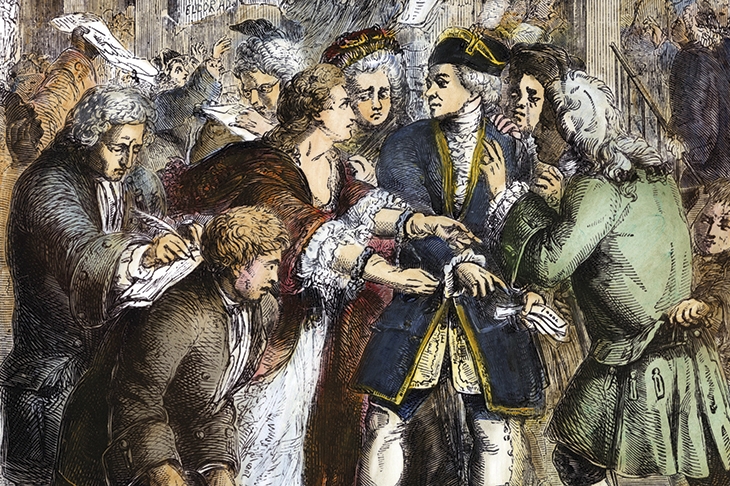In Money for Nothing, Thomas Levenson brings us into the story of the South Sea Bubble by writing about the development of the mathematics of odds and prediction. These advances were the beginnings of actuarial science: an understanding of risk that underpins insurance.
We start with Isaac Newton and his role in attempting to stabilise the currency with something we now think of as quite normal: currency revaluation (Levenson’s previous work on Newton means he’s well prepared here). Much of early modern Europe based their currencies on silver, and fluctuations in the value of the metal were a recurring issue. Ongoing wars meant England was massively in debt, and having its coins worth more (as silver bullion) than their face value in pounds was a problem. Silver coin was being taken out of the country to be sold in markets abroad.
Levenson moves on to how these things helped to influence the stock market, as trading in shares was gaining popularity. At the same time, the bond was emerging as a financial instrument.
The South Sea Company’s bonds were forerunners of the kind of money magic that brought us the 2008 crash
Of course people had lent money in the past, hence the prohibition of usury in many religions. Trying to make money from money is an ancient enterprise. But the creation of bonds as a form of government finance is more recent. In the 18th century, they tended to take various forms, including those that came with prizes as well as an annual return: a forerunner of today’s Premium Bonds.
Into this market, which had seen the success of the East India and Muscovy Companies, came the South Sea Company in 1711. It proposed to trade various commodities (including slaves) in South America. The colonies seemed to be a ticket to great wealth, so there were buyers ready to invest. Many of London’s major players were involved, and the company’s directors wanted to have the great and the good known to be investors. Daniel Defoe was also on hand, sceptically chronicling the growth of London’s stock exchange (then an informal collection of coffee houses along Exchange Alley, where traders congregated).
Bonds were key to the South Sea Company’s scheme, in which they would exchange shares for government bonds. Levenson is very fluent in his descriptions of precisely how these swaps worked, in a way that is clear to those without a financial background. And of course these are the forerunners of the kind of money magic that brought us the crash of 2008.
Unlike more recent ‘pump and dump’ schemes, it wasn’t intended to be a scam, or not entirely. The creators of the South Sea Company (as far as we can tell) hoped for their business to be a success — although they were skimming profits for themselves on the way. They did attempt trading journeys. They did attempt to sell commodities in the West Indies — to the bemusement of more established traders. They didn’t know what they were doing, but it wasn’t a complete fake. Global geopolitics got in the way of their ambitions: trading in Spanish territory was always going to be a dicey proposition and they were eventually locked out.
Inevitably the bubble burst, and the price of shares dropped from £1,000 to £100. The collapse led to public outrage, bankruptcy for investors and suicides of some of those ruined. The key players were not to walk away without punishment, as the government set about confiscating the assets of the ringleaders. (A more severe penalty than many of the 2008 scoundrels received, one might note.)
The crackdown was necessary to retain trust in the market, and in the system. Contemporary to the South Sea Bubble, the French had the Mississippi Bubble (engineered by an enterprising Scotsman, John Law) which turned into a national disaster. The Banque Nationale failed and the public lost faith in the French currency. The collapse of the South Sea Company didn’t create a concomitant collapse in Britain’s banking system, but it did lead to scepticism about bubbles and investment rushes. The wariness wasn’t permanent though: railway mania would lead to its own bubble in the 19th century. But, again, faith in the system and trust in the law continued. A belief in the rule of law, and that miscreants would be chased from the scene, helped make London the world’s financial capital, despite these periodic crazes.
It’s easy to look back and think of the South Sea bubblers, like the tulip-mad Dutch of the 1630s, as financially naive — until you remember how many people jumped in on various other more recent crazes (from Beanie Babies to Pets.com and Bitcoin). This is not a new tale, but Levenson tells it with a light touch.






Comments